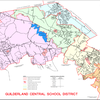Guilderland named a pro-housing community
GUILDERLAND — The town of Guilderland is the first municipality in Albany County to be certified as a Pro-Housing Community.
Kenneth Kovalchik, Guilderland’s town planner who spearheaded the drive for the designation, estimates that, of the state’s roughly 1,600 municipalities, Guilderland is in the first 10 percent to receive certification.
“This certification comes at an opportune time as the Town is in the process of updating the comprehensive plan and determining how we want our community to grow over the next 10 to 20 years,” Kovalchik wrote to The Enterprise in an email.
“Establishing ourselves as a pro-housing community,” he went on, “is one way in fighting back against the exclusionary and discriminatory ideologies that exist in our community, particularly when it comes to housing.”
A committee of residents appointed by the town board has been working with a consultant since November 2022 on updating Guilderland’s 20-year-old land-use plan.
In March, Kovalchik told the town board that, rather than superseding the committee, the town board, in adopting a resolution to become a pro-housing community, would be giving the committee direction on issues that need to be addressed.
The board unanimously supported the application.
A year ago, Governor Kathy Hochul signed an executive order to initiate the pro-housing program, increasing the chances of participating municipalities to get state grants. In a Feb. 22 editorial, The Enterprise urged local towns to join the program.
Also in February, Hochul had addressed representatives from the first 20 municipalities to sign on to the program, brandishing a bunch of carrots rather than the legislative stick she had tried unsuccessfully to use the year before.
“It’s a simple matter of supply and demand,” said Hochul; as more homes are built in New York state, prices will go down, she said.
Owning your own home, said Hochul, has always been the American Dream. New Yorkers are leaving to live in states with more affordable housing, some of them nearby, she said.
“We’re losing population … We’re losing political clout,” Hochul said, as, with fewer representatives in Washington, D.C., New York gets fewer federal benefits.
Guilderland had to show that its housing stock had increased by 0.33 percent in the last year or by 1 percent over the previous three years.
Kovalchik told the board in March that putting together the application was “quite extensive in terms of the data that we have to provide the state, going back to 2018 … And then there’s quite an extensive analysis of our zoning code that has to be provided to the state.”
Hochul had touted $650 million available through state programs, for which pro-housing communities could apply. But Kovalchik noted that, of the eight funding programs he listed in his memo, quite a few would not be relevant for Guilderland.
Among those that would be relevant is the Market New York program. “One of their goals is promotion of agritourism and craft-beverage tourism, which is quickly becoming a hot item here in the town with a lot of the vineyards and craft breweries that are popping up,” said Kovalchik.
He also mentioned Thacher park’s recent designation as a Natural Landmark and noted Guilderland is within the Hudson River Valley National Heritage Area. “So I think there’s a lot of opportunity here,” he said.
Kovalchik gave two examples of grant requests the town had made earlier of New York State Homes and Community Renewal. One was for the Pine Bush Senior Living facility and the other was for the Beacon Communities intergenerational housing project; both projects were dependent on grant funding.
“Each one of those projects were denied twice by Homes and Community Renewal,” said Kovalchik. “So I think, by becoming a Pro-Housing Community, that might help us with projects like that in the future.”
Superintendent Peter Barber said in March that the grant programs “are all geared towards workforce housing, affordable housing, senior housing.”
By adopting the resolution, the town agreed to streamline permitting for and adopt policies encouraging multifamily housing, affordable housing, accessible housing, accessory dwelling units, and supportive housing.
It also agreed to adopt policies that further fair housing, to incorporate regional housing needs into planning decisions, and to increase development capacity for residential uses.
Currently, Kovlchik said, just 1 percent of land in Guilderland is zoned for apartments and about 60 percent is zoned for single-family dwellings.
“If only 1-percent of your land is zoned to allow for higher density use, we need to look at that as part of the comp plan update,” said Kovalchik. “That should be one of the goals: In the next 20 years, where do you want to see growth and how do you protect a lot of the open space in ag[ricultural] uses?”
He added, “A way to do that is not extending water and sewer infrastructure and looking at infill development and redevelopment within your already existing built-up land, allowing more types of land uses in certain districts.”
RuthAnne Visnauskas, commissioner and chief executive officer of Homes and Community Renewal, wrote in a June 24 letter to Kovalchik, informing him of Guilderland’s certification as a Pro-Housing Community, that the town is now “eligible to apply for various discretionary funding programs with up to $650 million in funding available.”
“In New York State, rents have risen 40 to 60 percent since 2015 and home prices have risen 50 to 80 percent,” Visnauskas wrote. “More than half of New York renters are rent-burdened, meaning that they pay more than 30 percent of their income on rent — the second-highest rate in the nation.
“Here at HCR, we understand the nexus between supply and affordability. In order to achieve true equity of opportunity and to erase the gaps in access to health, education, and wealth-building, we must guarantee that people have a choice as to where they live and raise their families.”



